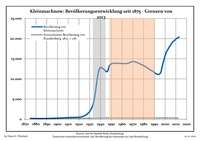Kleinmachnow
| Kleinmachnow | ||
|---|---|---|
| ||
 Kleinmachnow | ||
Location of Kleinmachnow within Potsdam-Mittelmark district  | ||
| Coordinates: 52°24′13″N 13°13′13″E / 52.40361°N 13.22028°ECoordinates: 52°24′13″N 13°13′13″E / 52.40361°N 13.22028°E | ||
| Country | Germany | |
| State | Brandenburg | |
| District | Potsdam-Mittelmark | |
| Government | ||
| • Mayor | Wolfgang Blasig (SPD) | |
| Area | ||
| • Total | 11.94 km2 (4.61 sq mi) | |
| Population (2015-12-31)[1] | ||
| • Total | 20,655 | |
| • Density | 1,700/km2 (4,500/sq mi) | |
| Time zone | CET/CEST (UTC+1/+2) | |
| Postal codes | 14532 | |
| Dialling codes | 033203 | |
| Vehicle registration | PM | |
| Website | www.kleinmachnow.de | |
Kleinmachnow is a wealthy municipality in the Potsdam-Mittelmark district, in Brandenburg, Germany.
Geography
It is situated 19 km (12 mi) southwest of the centre of Berlin, immediately neighbouring the borough of Steglitz-Zehlendorf, and 12 km (7.5 mi) east of Potsdam. The municipality encompasses the settlement of Dreilinden.
History

Kleinmachnow arose at the former Bäke creek, today replaced by the Teltow Canal built in 1906. Parvo Machenow was first mentioned in the 1375 land registry (Landbuch) of Emperor Charles IV, then also Brandenburg Elector. In medieval times the ford was controlled by a castle, recently held by the Hake noble family. Together with the canal the Kleinmachnow lock was erected, soon becoming a landmark.
From the early 20th century the former village developed to an affluent suburb of Berlin. In 1937 Wilhelm Ohnesorge, minister of the Reichspost, acquired the Hakeburg mansion as his residence and established a large research facility of communications-electronics here. In World War II Kleinmachnow was the site of a labour camp with about 5,000 inmates, including a subcamp of Sachsenhausen.

On the night of 2–3 December 1943, a Lancaster plane of the Royal Australian Air Force (flight LM 316) was shot down over Kleinmachnow, one of those killed being the well-known Norwegian writer and poet Nordahl Grieg, at the time serving as a war correspondent. (A memorial stone was unveiled at the site (52°23′51″N 13°12′58″E / 52.39750°N 13.21611°E) in November 2003.)
In 1946 the Socialist Unity Party of Germany (SED) seized the Hakeburg, which hosted the party's academy in the following years. From 1961 to 1989 the municipality was girded by the Berlin Wall on three sides and the motorway near Dreilinden (today Bundesautobahn 115) was the site of a major border crossing, counterpart of the Allied checkpoint Bravo in West Berlin. Since German reunification Kleinmachnow has seen a major increase of population, while the restitution of numerous plots in favour of those owners who had fled from the GDR led to fierce conflicts.
Demography
 Development of Population since 1875 within the Current Boundaries (Blue Line: Population; Dotted Line: Comparison to Population Development of Brandenburg state; Grey Background: Time of Nazi rule; Red Background: Time of Communist rule)
Development of Population since 1875 within the Current Boundaries (Blue Line: Population; Dotted Line: Comparison to Population Development of Brandenburg state; Grey Background: Time of Nazi rule; Red Background: Time of Communist rule) Recent Population Development (Blue Line) and Forecasts
Recent Population Development (Blue Line) and Forecasts
|
|
|
|
Politics
Seats in the municipal assembly (Gemeindevertretung) as of 2008 elections:
- Christian Democratic Union: 6 (21.0%)
- Social Democratic Party of Germany: 5 (19.7%)
- The Left: 4 (13.4%)
- WIR (independent): 4 (12.8%)
- Alliance '90/The Greens: 3 (11.0%)
- Free Democratic Party: 3 (10.3%)
- BIK (independent): 2 (5.7%)
- PRO (independent): 1 (3.5%)
Twin town
 Battambang, Cambodia
Battambang, Cambodia Schopfheim, Germany, since 1996
Schopfheim, Germany, since 1996
Notable people
- Lily Braun, feminist, born July 2, 1865 in Halberstadt, died August 8, 1916 in Berlin, lived in Kleinmachnow from 1909
- Friedrich Kayßler, actor, born April 7, 1874 in Neurode (Nowa Ruda), died April 24, 1945 in Kleinmachnow
- Arnold Schönberg, composer, born September 13, 1874 in Vienna, died July 13, 1951 in Los Angeles, lived in Kleinmachnow from 1911 to 1913
- Kurt Weill, composer, born March 2, 1900 in Dessau; died April 3, 1950 in New York City, lived in Kleinmachnow from 1932 to 1933
- Hanns Maaßen, writer, born December 26, 1908 in Lübeck, died June 23, 1983 in Mahlow, lived in Kleinmachnow from 1971
- Fred Wander, writer, born January 5, 1917 in Vienna, died July 10, 2006 in Vienna, lived in Kleinmachnow from 1958 to 1983
- Karl Gass, documentary filmmaker, born February 2, 1917 in Mannheim, died January 29, 2009 in Kleinmachnow, lived in Kleinmachnow from 1961 to 2009
- Christa Wolf, writer, born March 18, 1929 in Landsberg an der Warthe (Gorzów Wielkopolski), died December 1, 2011 in Berlin, lived in Kleinmachnow from 1962 to 1976
- Bushido, German rapper, living in his mansion.
References
- ↑ "Bevölkerung im Land Brandenburg nach amtsfreien Gemeinden, Ämtern und Gemeinden 31. Dezember 2015 (Fortgeschriebene amtliche Einwohnerzahlen auf Grundlage des Zensus 2011)". Amt für Statistik Berlin-Brandenburg (in German). 2016.
- ↑ Detailed data sources are to be found in the Wikimedia Commons.Population Projection Brandenburg at Wikimedia Commons
External links
![]() Media related to Kleinmachnow at Wikimedia Commons
Media related to Kleinmachnow at Wikimedia Commons
